
About UsThe Numismatic Bibliomania Society is a non-profit organization promoting numismatic literature. For more information please see our web site at coinbooks.org SubscriptionsThose wishing to become new E-Sylum subscribers (or wishing to Unsubscribe) can go to the following web page link MembershipThere is a membership application available on the web site Membership Application To join, print the application and return it with your check to the address printed on the application. Membership is only $15 to addresses in the U.S., $20 for First Class mail, and $25 elsewhere. For those without web access, write to: David M. Sundman, Secretary/TreasurerNumismatic Bibliomania
Society AsylumFor Asylum mailing address changes and other membership questions, contact David at this email address: dsundman@LittletonCoin.com SubmissionsTo submit items for publication in The E-Sylum, just Reply to this message, or write to the Editor at this address: whomren@coinlibrary.com
BUY THE BOOK BEFORE THE COINYou won't regret it! |
- WAYNE'S WORDS: THE E-SYLUM JUNE 6, 2010
- ORVILLE GRADY RELEASES LATEST NUMISMATIC LITERATURE FIXED PRICE LIST
- SKLOW NUMISMATIC LITERATURE SALE #10 CLOSES JUNE 12, 2010
- KOLBE & Fanning STACK'S LIBRARY II SALE RESULTS
- NEW BOOK: CONFEDERATE TREASURY CERTIFICATES
- NEW BOOK: MODERN FEDERAL RESERVE NOTES, 1963–2009
- NEW BOOK: MEDALS AND PLAQUETTES FROM THE MIDDELDORF COLLECTION
- NEW BOOK: GOLD COINS IN THE COLLECTION OF THE ASIATIC SOCIETY
- HARVEY STACK ON THE VALUE OF BOOKS
- EXHIBIT: PRECIOUS METALS: FROM AU TO ZN
- MEDALLIC ART COMPANY APPOINTS DICK JOHNSON CORPORATE HISTORIAN
- HERITAGE OFFERS EDWARD ROEHRS COLLECTION OF U.S. REGULATED GOLD
- MORE ON THE COLUMNS OF THE SECOND PHILADELPHIA MINT
- QUIZ QUESTION: HOW MANY DIFFERENT U.S. MINT BUILDINGS?
- MYSTERY NUMISMATIST REVEALED: "YN OF THE CENTURY"
- EXPERIMENT: WERE ANCIENT COINS STRUCK HOT OR COLD?
- MORE ON THE 1794 DOLLARS
- ON FINDING HARD-TO-FIND LOW-PRICED WORLD COINS
- DICK JOHNSON ON PRESIDENTIAL COIN &ANTIQUE CATALOGS
- GLOUCESTER TOKEN REPRODUCTIONS OFFERED
- NOTES FROM E-SYLUM READERS: JUNE 6, 2010
- WAYNE'S NUMISMATIC DIARY: JUNE 6, 2010
- NEW CURRENCY ADVOCATED FOR PALESTINE
- TECH TALK: COIN STRIKING PRESSURE CALCULATIONS
- COMMENTARY ON THE COIN DOCTOR LAWSUIT
- STILL MORE ON CHINESE COUNTERFEITS
- PHILIPPINE GUERILLA NOTE FAKES
- SOLDIERS RETURNING WITH FAKE U.S. COINS
- THE 1944 SILVER SAUDI RIYAL COIS
- BRITISH ARTIST CREATES PORTRAIT OUT OF PENNIES
- LORD ASHCROFT ON THE VICTORIA CROSS
- FEATURED WEB SITE: CHINESE REPLICAS OF FRENCH COINS
WAYNE'S WORDS: THE E-SYLUM JUNE 6, 2010

Among our new subscribers this week are Phoebe Stiles of Hallenbeck Coin Gallery, Charlie Ludvik, and returning subscriber Peter Mosiondz, Jr. Welcome aboard! We now have 1,345 subscribers.
Life throws you a surprise every once in a while. I got one on Tuesday while driving my nine-year-old son Tyler to his Little League game. I stopped at an intersection waiting for traffic to clear so I could make a left-hand turn. After two oncoming cars passed through I was about to start my turn, when WHAM!
We were hit from behind by another car that must have been going over forty miles an hour. No horn, no brakes, just WHAM! My car was pushed halfway to the next intersection before it stopped. The driver's seat collapsed backward and I ended up looking at the roof. I wasn't sure which end was up. But I sat up and looked back to see if Tyler was all right. Thank God he was, and so was I.
The back window had shattered and safety glass was all over the back seat next to Tyler. I dialed 911 but a Sheriff's vehicle was already on the way to us. I called my wife and told her 1) we're OK and 2) what happened. I got out of the car. I couldn't open Tyler's door, so I had him crawl to the front seat and get out the passenger's side.
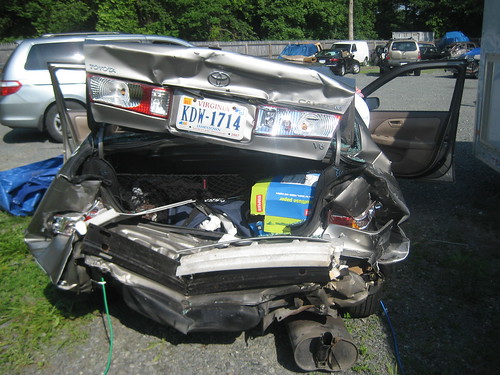
When the officer arrived Tyler rode in his car while I drove my mangled car up and around the next corner. I got out and for the first time got a good look at the damage. Say what you will about Toyota safety today, but that ten-year-old car saved our lives. The whole back end collapsed. It's hard to believe we walked away from it.
My frantic wife arrived and gave us hugs. She carefully extracted our son's equipment bag from what remained of my trunk, and took him to his game. The tow truck driver gave me a ride to the field. Tyler played a great game!
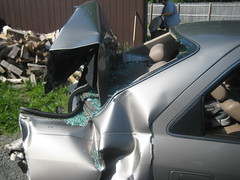 Everyone suspects the young woman driving the other car was texting or otherwise distracted. Luckily, she was unhurt too, and didn't contest the charges against her.
Everyone suspects the young woman driving the other car was texting or otherwise distracted. Luckily, she was unhurt too, and didn't contest the charges against her.
Tyler had to take pictures of the car to school on Thursday since his friends didn't believe his story. Me, I remember what happened every time I move my neck. Can anyone recommend a good Virginia auto injury lawyer? At least I can still type unimpeded, so let's get back to numismatics.
First, I'd like to thank John Salyer for helping upload some of the images in this issue to our Flickr archive. To add insult to injury, our Internet connection was down for a couple days this week. Apparently our Comcast cable line was "accidentally" cut by workers installing Verizon FIOS nearby...
This week we open with items from three numismatic literature dealers, and announcements of FOUR new numismatic books. Next, we have an essay from Harvey Stack on the value of books and announcements from the Massachusetts Historical Society and Medallic Art Company.
Other topics include U.S. Regulated Gold, finding hard-to-find "common" world coins, the Gloucester token, and the 1944 Saudi silver riyal. To learn about Confederate interim depository receipts, the Middeldorf collection of medals and plaquettes, and the identities of our mystery "young numismatist" and the new historian of Medallic Art Company, read on. Have a great week, everyone!
Wayne Homren
Numismatic Bibliomania Society
ORVILLE GRADY RELEASES LATEST NUMISMATIC LITERATURE FIXED PRICE LIST
From time to time we send out a list of current inventory for sale. Please advise of any items of interest, if you have a question about any item feel free to inquire. Orders over $200 receive a 15% discount, shipping determined on a per order basis. Payment accepted by check or via "Paypal". Thanks, Orville.
Orville J. Grady
Numismatic Literature Bought and Sold
705 Howard St.
Scribner, NE 68057
800-295-4846
www.gradybooks.com
SKLOW NUMISMATIC LITERATURE SALE #10 CLOSES JUNE 12, 2010
Just a last reminder that Numismatic Literature Mail Bid Sale # 10 closes Saturday June 12th. There is still time to submit your bids; Via Email, Fax, USPS &Phone. Phone bids are accepted until 8pm [MT] on closing day
Email, Fax and bids left on our answering machine are accepted until Midnight on closing day.
Look forward to seeing you at ANA Summer Seminar or at the ANA Convention in Boston!
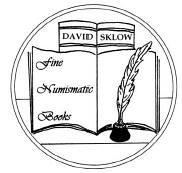 David Sklow-Fine Numismatic Books
David Sklow-Fine Numismatic Books
P.O. Box 6321
Colorado Springs, CO 80934
PH: 719-302-5686
FAX: 719-302-4933
EMAIL: numismaticbooks@aol.com
WEB:
FineNumismaticBooks.com
KOLBE & Fanning STACK'S LIBRARY II SALE RESULTS
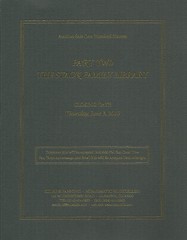 On Thursday, June 3, Kolbe & Fanning Numismatic Booksellers held the second sale of the Stack Family Numismatic Library, featuring many important and useful works on U.S., foreign and ancient numismatics.
On Thursday, June 3, Kolbe & Fanning Numismatic Booksellers held the second sale of the Stack Family Numismatic Library, featuring many important and useful works on U.S., foreign and ancient numismatics.
Nearly 200 bidders participated in the sale, including bidders from Europe, Asia, Africa, Australia and the Americas. The sale brought over $140,000, slightly over the pre-sale estimated value. Some highlights include:
- Lot 390, the Coin Galleries set of Stack's catalogues, brought $21,000 on a $10,000 estimate
- Lot 517, a nearly complete set of Numismatic Notes and Monographs, brought $4500 on a $4000 estimate
- Lot 399, the Stack's office copy of the Brobston fixed price list of United States half cents, identifying many purchasers from this important list, brought $3200 on a $1000 estimate
- Lot 389, a daybook and ledger used by the Stack Family to record the sales from their early years, including their first auction, brought $3000 on a $2500 estimate
- Lot 266, a bound volume of rare George A. Leavitt sales, brought $2700 on a $500 estimate
- Lot 642, a beautifully bound first edition copy of Dalton and Hamer's important work on Conder tokens, brought $1750 on a $1000 estimate.
The catalogue and prices realized list for this sale can be found on the Kolbe & Fanning website at www.numislit.com. This was the first sale conducted by the new joint venture between George F. Kolbe and David F. Fanning, who combined their respective numismatic literature businesses earlier this year.
The firm's next auctions will be the September 12 sale of select antiquarian items from the Anders Frösell library and the September 16 sale of the library devoted to ancient coins, art and antiquities formed by Robert J. Myers.
On November 18, the firm will be conducting a further mail-bid sale, for which consignments are still being accepted.
On January 8, 2011, Kolbe & Fanning will be holding a public auction at the Waldorf‐ Astoria hotel in conjunction with the New York International Numismatic Convention. Select consignments of important numismatic works are currently being solicited for this sale.
Queries may be directed to David F. Fanning at df@numislit.com or (614) 414-0855, or to George F. Kolbe at gfk@numislit.com or (909) 338-6527.
NEW BOOK: CONFEDERATE TREASURY CERTIFICATES
 Collectors of Confederate fiscal paper have long been fascinated by the interim depository receipts (IDRs) and exchange certificates. This book explores the history of these important fiscal documents that bridged older issues of paper money to bonds or newer issues of paper money. The printers of official Confederate treasury notes and bonds could not keep up with demand for new paper money and print bonds to redeem the old paper money.
Collectors of Confederate fiscal paper have long been fascinated by the interim depository receipts (IDRs) and exchange certificates. This book explores the history of these important fiscal documents that bridged older issues of paper money to bonds or newer issues of paper money. The printers of official Confederate treasury notes and bonds could not keep up with demand for new paper money and print bonds to redeem the old paper money.
Hence, the Confederate Treasury resorted to certificates of indebtedness or interim receipts. These were used to borrow money temporarily while new issues were substituted for the old paper money or to satisfy claims of those who had bought bonds which the treasury did not have on hand. See Figure for an example of an IDR issued by the depositary at Selma, Alabama.
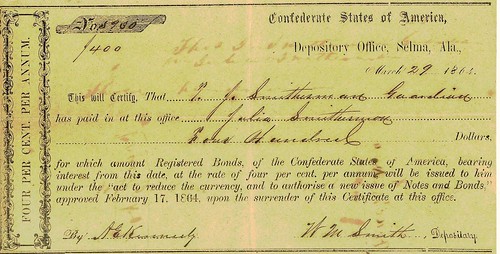
IDR issued at Selma, Alabama in 1864 by W. M. Smith, Depositary.
In 1998, two great researchers and collectors of IDRs, Dr. Douglas B. Ball and John Martin (Marty) Davis, began collaborating on a definitive reference and history of these interesting documents. Unfortunately, Dr. Ball's untimely death in 2003 ended this partnership. Subsequently, Pierre Fricke acquired Dr. Ball's work, and more recently, Marty Davis approached George Tremmel to help author a book based on his earlier research. Tremmel contacted Fricke in late summer 2008 and the old collaboration was resumed.
The book will be available in limited quantities at the Memphis International Paper Money show at Pierre Fricke's table (#1006 on the left wall). Be sure to stop by early in the show to get one as we expect to sell out. The authors will present the work at the annual author's forum at Noon on Friday June 18, 2010 at the show.
Later in July, the book will be available in quantity for retail and reseller purchase. Contact Pierre Fricke for more information on how to buy individual books or for dealer prices.
512 Pages, Full Color, Profusely Illustrated
Retail Price $60
Pierre Fricke
pfricke@csaquotes.com
P.O. Box 52514
Atlanta, GA 30355
NEW BOOK: MODERN FEDERAL RESERVE NOTES, 1963–2009
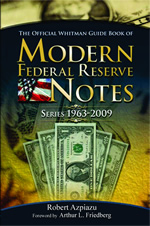 Nationally known numismatic researcher and paper-money dealer Robert Azpiazu explores modern Federal Reserve Notes of the $1, $2, $5, $10, $20, $50, and $100 denominations in this new guidebook from Whitman Publishing. Drawing on his own expertise, as well as assistance from a distinguished panel of contributors, Azpiazu presents a detailed and reader-friendly study targeted at FRN collectors–the largest segment of the U.S. paper–money market.
Nationally known numismatic researcher and paper-money dealer Robert Azpiazu explores modern Federal Reserve Notes of the $1, $2, $5, $10, $20, $50, and $100 denominations in this new guidebook from Whitman Publishing. Drawing on his own expertise, as well as assistance from a distinguished panel of contributors, Azpiazu presents a detailed and reader-friendly study targeted at FRN collectors–the largest segment of the U.S. paper–money market.
Azpiazu's coverage also includes Bureau of Engraving and Printing (BEP) products not made for general circulation and not currently covered in the hobby's standard references.
This softcover, 6 x 9–inch book will debut in the fall of 2010.
To read the complete article, see: Modern Federal Reserve Notes, 1963–2009 (www.whitmanbooks.com/Default.aspx?Page=55&HTMLName=ReviewUpcoming_0610)
NEW BOOK: MEDALS AND PLAQUETTES FROM THE MIDDELDORF COLLECTION
In collaboration with Indiana University Press, we are publishing a book by Arne Flaten, Medals and Plaquettes from the Middeldorf Collection at the Indiana University Art Museum.
The book manuscript is by Arne Flaten, who earned his Ph.D. in art history from Indiana University. He is currently Associate Dean and Associate Professor of Art History at Coastal Carolina University. The manuscript is about the Middeldorf collection of medals and plaquettes, includes pieces from seven European countries, from the fifteenth to the twentieth centuries.
As you probably know, Professor Ulrich Middeldorf was one of the world's most renowned scholars on Renaissance medals, and his personal collection was given to the IU Art Museum by his widow Gloria. Professor Middeldorf was for years director of the distinguished research center, the Kunsthistorisches Institut in Florence.
The book will include about 350 color illustrations, and each will have its own entry describing the work's origins, etc. We hope to include the image of the reducing machine in the book's introduction. The manuscript is ready for submission to the publisher but is not yet in the hands of a designer.
NEW BOOK: GOLD COINS IN THE COLLECTION OF THE ASIATIC SOCIETY
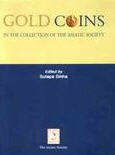 The present catalogue is a classified catalogue of the gold coins now preserved in the Society's cabinet. Most of these are pagodas and fanams of South India, presumably collected from Tipu Sultan's Treasury long ago. There are also two Kushana gold-coins of the Third Century A.D., Indo-British Star Pagodas, Afghan-Durrani Coins, a few Ottoman gold coins. Venetian Gold Ducats, of Malay, and a few "unattributed" pieces. The variety is numismatically important.
The present catalogue is a classified catalogue of the gold coins now preserved in the Society's cabinet. Most of these are pagodas and fanams of South India, presumably collected from Tipu Sultan's Treasury long ago. There are also two Kushana gold-coins of the Third Century A.D., Indo-British Star Pagodas, Afghan-Durrani Coins, a few Ottoman gold coins. Venetian Gold Ducats, of Malay, and a few "unattributed" pieces. The variety is numismatically important.
This catalogue has been prepared by the Late Dr. Rita Sharma with meticulous care, and competently edited by Dr. Sutapa Sinha. The illustrated catalogue would certainly be useful to the students of Numismatics and History, and would be appreciated by the general readers.
Contents: Foreword. Preface. Acknowledgement. 1. Introduction. 2. Descriptive catalogue of gold coins: i. Non-Islamic Indian coins. ii. Islamic Indian coins. iii. Foreign coins. iv. Unattributed Gold pieces. Index.
Author(s) : Sutapa Sinha (ed.)
Format : Hardcover
Pages : xiv+138p., B/W Plates; Illustrations; 25cm.
Pub. Date : 01 Jan 2010 , 1st ed.
Publisher : Asiatic Society
Language(s) : English
For more information, or to order, see: Gold Coins in the Collection of the Asiatic Society (www.bagchee.com/en/books/view/59860)
THE BOOK BAZARRE

HARVEY STACK ON THE VALUE OF BOOKS
From the very first day I became a full-time Numismatist, some 62 years ago, (and this doesn't count the apprentice years while I was going to school,) I learned from my family seniors, Joseph Stack, my uncle and Morton Stack my father, that in order to know about Numismatics, one must use the many books available on the hobby.
In fact, when I became one of the senior members of the firm, my office, which I shared with Norman Stack, my cousin, for over 30 years, housed from ceiling to floor, on two sides, the most used library that Stack's had. (And these were only on United States coins!)
The balance of the library was housed in various offices of our cataloging staff, and on a huge wall at our second floor office. We were surrounded by books, catalogs and writings on this vast subject, which covered coins, of all metals and currency from all parts of the world, from ancient times to the modern issues.
We were trained to use the books, and ours were a true "working library", in order to catalog coins for sale and verify various pedigrees. The more we read , the more we learned. Our library was always available to those who sort the same information we did. Actually our offices were considered a "club house" as collectors and dealers visited and used the facilities we at STACK'S kept available. So my background was founded in study in order to keep up with the specialists and help the beginners.
Many of the great collectors, researchers, authors and dealers frequented Stack's to look at coins, study our inventory or just came to meet fellow numismatists for friendly as well as informative get-togethers ,and make use of our library for study and research .. (I will write more about the "club house atmosphere in a later story)
Back to the books. We scanned many price lists, ads and auctions to add to our library. If we had a very special assignment to help acquire and build a very complete series we always sort to get more books to help do our assignments.
Such an assignment came to us in 1954 from a very dedicated collector, Mr. Josiah K. Lilly, chairman of Eli Lilly &Co, He had a profound love of history, and started collecting in 1951 his great collection of Gold Coins of the World, and with a strong specialty in the coins of the United States.
Before he died in 1967 he assembled some 6500 Gold coins, from ancient to modern times, with special interest in Spanish Colonial, England , France and the United States. His interest started with the foreign issues, as he had a love of the history of the sea, and how the growth of America, as it grew. It was fascinating to serve him as he always wanted to know how and why certain issues occurred, the story the coins told and the interest that aroused collecting.
One of great interests was PIONEER and TERRITORIAL ISSUES. Not only did he attempt to have as complete collection as possible of these numismatic items. but he wanted to know also about the history of the West, the commercial and development of this wild and exciting place, which later became part of the United States,
In our search for rare and unusual coins, ingots, nuggets and other related artifact of the Early Western Period we not only wanted to get the monetary items but any books that would mention the miners, assayers , coiners, bankers and the like which were active during this hectic period.
In early 1955 we were sent an very unusual item. It was either a piece of money or a gambling chip. The value was $20.00 , and it was struck in gold. The legend that appeared on it was DIANA GAMES OF CHANCE TWENTY DOLLARS CLAY AND MONTGOMERY STREET SAN FRANCISCO 1854. It was the first item of this kind we ever saw.
We first searched all the text books and business directories of San Francisco and couldn't find DIANA mentioned. It was well struck, the proper weight and looked like a $20.00 gold piece, to be used in the gambling casinos. We decided to have researchers in San Francisco go over all the records of the period, and not only search in the San Francisco references but also try to research the records that might be in Sacramento. After months of searching we were unable to uncover any specific records.
As I wrote earlier, we were always searching for books and references, and one day a book arrived, which was a narrative, no doubt taken from a diary, published in 1855. I sat down to read it to get more local color and information to send on to Mr. Lilly. The book was entitled 'LAND OF GOLD', written by HINTON R. HELPER and published for the author by Henry Taylor, Baltimore 1855.
It covered the journey of Mr. Helper to explore California the previous three years (1852-l854).spoke of the Life Style, industry, morals, agriculture, mining and panning for gold as he experienced it first hand, He began his writings after he arrived in San Francisco and was astounded by what he witnessed about him. It was a revealing narrative and quite explicit about the life and death struggles for the new country being developed. He writes as he was walking through the streets of lower class and then upper class residents he discovered the way of life that attracted winners and losers. It was the "gambling Casinos." In order to describe graphically what he saw he wrote about DIANA, GAMES OF CHANCE. Following is a direct quote from his narrative.--
"The gambling-houses cannot be overlooked in a true sketch of life in San Francisco. One of the largest and most frequented of these, called the Diana, stands a few doors above us. The building extends, through the entire block from Clay to Commercial Street and has a front proportionate to its depth. The doors, which lead into it from either street, are kept wide open from nine in the morning till twelve a night is generally filled to overflowing with lazy men, of little principle, whose chief employment consists in devising some sinister plans of procuring a livelihood without working.-------"
He goes on to describe the block-long bar surrounded by pictures representing nude women in every imaginable posture.
Around the floors were numerous gambling tables, rented by the owners to those who needed a table to ply their trade. Chips consisted of tokens, gold coins, bags of dust, ingots, nuggets and the like. The readily found gold was the goal of the various players. The book continues with other life styles he encountered, from the City Life to the tent and camping sites he ventured to get a full picture of Life in the Golden State, including the unfortunates as well as those who might have "struck it rich"
WOW ! EUREKA ! Here, in this small volume, measuring 5 x 7 inches, of some 300 pages was the key we sought to confirm that this was a struck coin (or CHIP if you wish) that we were unable to find a source for what we had sent to us sometime before. We contacted various researchers in California, who said that probably the reason we had such a time locating this Company was because San Francisco as well as Sacramento had numerous fires in the early 1850s and must records such as street maps and places which were originally standing, were destroyed by fire and records no longer existed. One researcher in Sacramento did find some reference to the proprietors of Diana in a law suit filed in the mid 1850's after Mr Holder returned to the East to have his book published.
This book, which was written and published in 1855 was the major key to our being able to send it on to Mr. J.K. Lilly. It, together with the vast collection of some 6500 coins, resides in the National Collection at the Smithsonian, in Washington, D.C. The Lilly Collection became part of the NATIONAL COLLECTION IN 1967 after Mr. Lilly passed away, by an ACT OF CONGRESS.
YES, INDEED. Coins have value but books can make them real and sometimes tell stories that amaze us. Numismatics is a great study for determining places and things !!
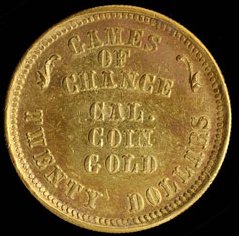

Twenty dollars, n.d. Diana Gambling House (?), San Francisco. Gold. 34 mm. This piece is likely to be a modern fantasy from the mid-twentieth century. Fantasy pieces can take advantage of an intense enthusiasm for material related to the old West, the California Gold Rush, and the pioneer spirit in search of the American Dream.
Material(s): Gold
Measurements: Overall: Dia. 33.4 mm, Wt. 33.351 g.
Place Made: United States, California
Credit Line: Lilly, Josiah K
Object ID: NU*283645.1074
Subject(s): Coins, Currency and Medals
To read the original online collection record, see United States, $20 (California--private issue) (americanhistory.si.edu/collections/object.cfm?key=35&objkey=4473)
THE BOOK BAZARRE
EXHIBIT: PRECIOUS METALS: FROM AU TO ZN
While the American Numismatic Association (ANA) is in Boston this summer, the Massachusetts Historical Society (MHS) is taking the opportunity to show off some of its numismatic treasures. From August 2 through September 11, "Precious Metals: From Au to Zn" will be on display in the Society's building at 1154 Boylston Street — just three blocks west of the Hynes Convention Center.

Diplomatic medal of the States-General of the United Provinces of Holland given to John Adams on 6 March 1788. Gold medal by [K], [circa 1788.]
Special guest curator John W. Adams and MHS Curator Anne E. Bentley have planned an exhibition to highlight many of the rare and unique pieces in the collection. A small sampling includes the NE two pence and shilling and the 1776 Massachusetts Pine Tree copper penny for the coin collectors. A piece of original Massachusetts-Bay stock and the February 1690/1 Massachusetts Bill of Credit, along with some special colonial notes and obsolete bank bills will tempt the paper specialists.
Medal collectors will be drawn by the full set of Washington-Webster silver Comitia Americana medals, as well as what is possibly the only surviving example of an 18th century diplomatic medal, that was presented by the United States General of the Netherlands to envoy John Adams. Medals from the Betts series, Indian Peace Medals of colonial and federal issue, school and personal medals will also be on view.
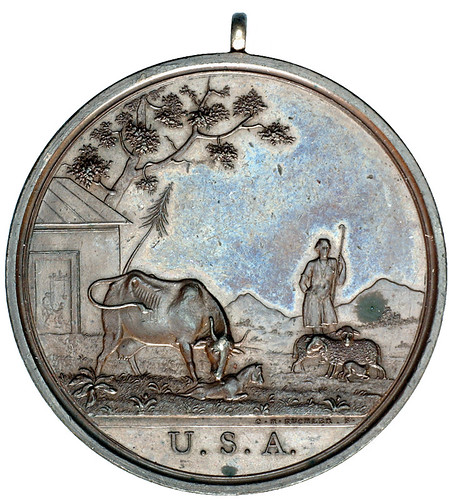
Seasons Indian peace medal; the shepherd. Silver medal engraved by Conrad Heinrich Kuchler after a design by John Trumbull, 1798.
The MHS will display a generous number of Washington medals from the Baker series and will feature some fascinating pieces from the Vernon medal series. As well, there will be a display of awards and badges that honor medical and military victories. There is something for everyone at the Massachusetts Historical Society.
Regular public hours are from 1 to 4 PM, Monday through Saturday, and there are special ANA morning hours, from 9 AM to noon, on August 10-14. If convention attendees plan to research the MHS collection while in town, please contact Anne Bentley in advance to make an appointment, as time and space are limited at abentley@masshist.org or call 617-646-0508.
About the MHS Numismatic Collection
Created as a repository and a publisher to collect, preserve, and disseminate resources for the study of American history, the Massachusetts Historical Society has been collecting numismatic material since it first opened in 1791. Coins, ancient and "modern" [i.e. colonial American], paper currency, and medals of all classes were grist to our mill. Over this period the Society has enjoyed the support and guidance of several of the hobby's notables, including earlier luminaries and MHS members William Sumner Appleton, Malcolm Storer, and Shepard Pond; and more recent numismatic collectors and authors John W. Adams, the late Douglas Ball, and Q. David Bowers.
To read the earlier E-Sylum article, see: MASSACHUSETTS HISTORICAL SOCIETY PLANS ANA NUMISMATIC EXHIBIT (www.coinbooks.org/esylum_v13n21a04.html)
MEDALLIC ART COMPANY APPOINTS DICK JOHNSON CORPORATE HISTORIAN
as Corporate Historian
Century-Old Company Known for Creating Some of the
Most Noted Medals in America
Medallic Art Company of Dayton, Nevada, has appointed former employee D. Wayne Johnson as corporate historian and senior consultant. The appointment was made by Ross Hansen, company president.
Dick Johnson was director of research with Medallic Art Company from January 1966 until December 1976. In that position he conducted sales research for the great outpouring of medals issued for the 1976 American Bicentennial. He created an archive and cataloged all the firm's previous medallic issues back to 1906. He also edited The Art Medallist, a company newsletter for collectors and the public. He served as assistant to the president at the time, William T. Louth, for whom he wrote speeches, particularly for the numismatic field.
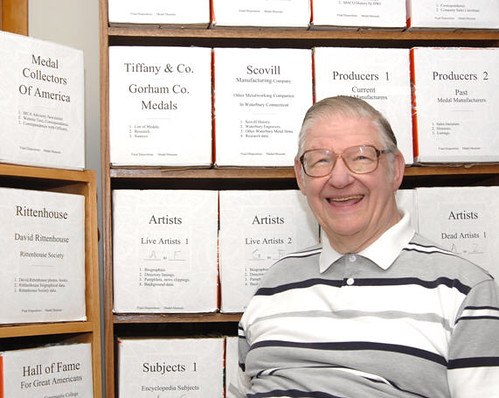
Since its founding in lower Manhattan at the beginning of the 20th century, Medallic Art Company has replicated the medallic work of the most famous sculptors of America. It had a part in producing a Benjamin Franklin medal for Augustus Saint-Gaudens before the great artist's death in 1907. That medal was issued by Tiffany &Co., which began a long-term relationship with the firm.
In 1906, the founders of the company imported the first Janvier pantographic reducing machine to America. Because of its superior qualities, this machine was employed to make reductions of models and cut dies and hubs, even for the U.S. Mint – making prototypes of coin models for circulating and commemorative coins – until the Philadelphia Mint acquired a Janvier pantograph of its own.
The two company founders, Henri and Felix Weil, who had served as sculptors’ assistants for more than two decades prior, continued to serve artist friends in their medallic needs. They struck the first medals for the Circle of Friends of the Medallion, and in the decades to follow struck the entire series of medals of more than 125 American artists for the prestigious Society of Medalists.
The firm is also known for creating some of the most noted medals in America: the Pulitzer Prize medal, the Peabody Award medal, and the Caldecott and Lippincott Medals. It has also created inaugural medals for eleven Presidents of the United States.
Ross Hansen, president of Northwest Territorial Mint, LLC, purchased Medallic Art Company on July 10, 2009, and moved all coin and medal production to the Dayton, Nevada facility. The combined operation also has a production and sales facility in Green Bay, Wisconsin, and sales offices in Federal Way, Washington, Springfield, Virginia, and in the Pentagon, where orders for military medals and challenge coins are received. Northwest Territorial Mint also markets precious metal bullion to investors.

In its 100-year history, Medallic Art Company has been located in four cities at separate times. From its origin in New York City it moved to Danbury, Connecticut, in 1972, and to Sioux Falls, South Dakota, in 1991. In 1997 it relocated to Dayton, Nevada, in the heart of the historic Comstock silver mining area. It currently occupies a massive, 2-story, 118,000-square-foot building.
Dick Johnson, who writes under the name D. Wayne Johnson, is a life-long numismatist. A coin collector since February 1939, he was the founding editor of Coin World in 1960, now in its 50th year. Following his employment with Medallic Art, he formed an art medal dealership in 1977 with medal enthusiast Chris Jensen, and the pair conducted 27 auction sales under the banner of Johnson &Jensen.
Mr. Johnson will retain his position as curator of numismatic art at the Belskie Museum of Closter, New Jersey, to which he was appointed in 2005. This museum is named after Abram Belskie, a sculptor of medallic art and a series of medical medals, all of which Johnson has cataloged.
In November 2008, Mr. Johnson joined with Mark Schlepphorst to form Signature Art Medals to market high quality medallic art. The firm's first production was a Lincoln/Brenner plaquette honoring the bicentennial of Abraham Lincoln's birth and the centennial of the Lincoln cent. It was struck by Medallic Art Company.
Mr. Johnson is the author of over 200 articles and more than 800 brief items in The E-Sylum, a newsletter in the numismatic field. His more serious work at present is a directory of American coin and medal artists, now numbering more than 3,150 such artists, and an encyclopedia of coin and medal technology with 1,842 major entries.
In serving as corporate historian for Medallic Art Company, one of Johnson's early priorities in his new position will be to write a history of the company and a catalog of all the firm's previous medallic issues. Among his most recent work is "Objects of Desire" on medallic objects. It was published in The Numismatist, September 2007.
For more information about Medallic Art Company, visit www.Medallic.com. For more information about Northwest Territorial Mint, visit www.NWTMint.com.
HERITAGE OFFERS EDWARD ROEHRS COLLECTION OF U.S. REGULATED GOLD
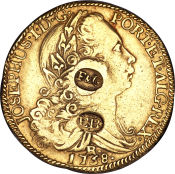 We are proud to present the intriguing Edward Roehrs Collection of U.S. Regulated Gold, including 73 different examples, at the Official World Coin Auction of the Boston ANA World's Fair of Money, August 8-16, 2010.
We are proud to present the intriguing Edward Roehrs Collection of U.S. Regulated Gold, including 73 different examples, at the Official World Coin Auction of the Boston ANA World's Fair of Money, August 8-16, 2010.
One of the most fascinating and important episodes in America's coinage history occurred in the early national period. Ephraim Brasher's "EB" counterstamp, so well known thanks to the famous Brasher doubloons, was part of a much wider process in Confederation-era New York. Various jewelers were authorized to weigh and correct coin weights to ensure that the important trade with West Indies used foreign gold coins at their full value.
Thus, we find the counterstamps of Regulators Ephraim Brasher, John Burger, Joseph Richardson, Robert Cruikshank, Myer Myers, and Daniel Van Voorhis, on host coins from several countries, especially punches applied to gold plugs inserted to raise weight/gold content, including Brazil, Portugal, and England. Plus, this collection will include newly discovered goldsmiths whose products will be offered publicly for the first time.
This ingenious solution, using well-known goldsmiths to mark or plug coins, became widespread throughout the West Indies and it has been within collections of that specialty that many of these important American artifacts have long hid from view. The usual rules of numismatic value do not apply to these "Regulated" coins. Their enhanced value is created by actions that would reduce the value of other coins, such as drilling, plugging, and counterstamping. Indeed, these dynamic processes enrich their history and value, then the history of any individual regulated coin is further amended by actions taking place after regulation.
Regulated gold coins were typically found only in the most advanced collections formed in the early 20th century (and often very few examples) such as Garrett, Eliasberg, Ten Eyck, Ford, Roper, Brand, Jackman, and Newcomer. The few surviving examples often come with impressive pedigrees.
This catalog, with new research on smiths, weight standards, and provenance, will become a textbook in a field that has suffered from a lack of information. Reserve your copy now, and plan to participate in one of the most important specialized offerings of early American coins ever held.
- France: Louis XV Louis d'or aux lunettes 1735-R. Orleans mint. EB mark in oval for Ephraim Brasher.
- Brazil: Jose I 6400 reis 1758-R. Rio mint. EB mark in oval for Ephraim Brasher, F+G mark in oval for Lewis Fueter and G.
- England: George III guinea 1775. Script JB monogram for John Burger.
- Brazil: Joao V 12800 reis 1730-M. Minas Gerais mint. IR mark for Joseph Richardson, Jr.
- Chile: Carlos III 8 escudos 1775 DA. Santiago mint. EB in oval for Ephraim Brasher.
- Brazil: Jose I 6400 reis 1771-R. Rio mint. MM mark for Myer Myers.
- Portugal: Joao V 6400 reis 1739. Lisbon mint. EB mark for Ephraim Brasher. F&G mark for Lewis Fueter and G.
- Brazil: Joao V 6400 reis 1739-B. Bahia mint. F&G mark of Lewis Fueter and G.
- Brazil: Jose I 6400 reis 1756-R. Rio mint. Marked RH for Richard Humphreys.
- Brazil: Jose I 6400 reis 1753-B. Bahia mint. DV for Daniel Van Voorhis.
- Brazil: Joao V 6400 reis 1737-B. Bahia mint. TP for Thomas Pons, Boston.
To view the complete catalog, see: coins.ha.com/common/auction/catalog.php?Sale_No=3010
MORE ON THE COLUMNS OF THE SECOND PHILADELPHIA MINT
Last week Kay Freeman noted that the six ionic columns that were once part of the Philadelphia Mint (built in 1833) are now free-standing outside of the Albert Einstein Hospital on North Broad St. in Philadelphia. I was unable to locate an image of the columns today.
Bob Van Arsdell writes:
If you Google Albert Einstein Hospital and then go to "images", there is a photo of the columns being erected in front of the hospital. The caption identifies the columns as the ones from the mint.
Max Spiegel also found this photo. He writes:
I was able to find one picture online. It's on the website of an engineering consulting firm, and it sounds like the columns were removed and placed in storage. That would explain why it is so difficult to find images of them online.
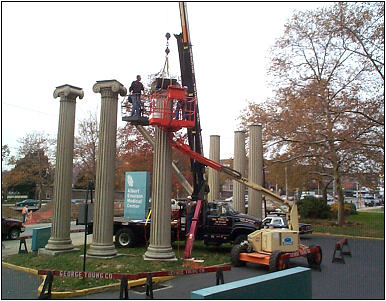
Prepared and developed construction documents for the removal and storage of six historic columns. Standing 30 feet and weighing 28,000 lbs, the columns were originally designed by William Strickland. The columns were part of the United States Mint in downtown Philadelphia and later donated to the hospital in 1904. These columns were originally constructed in the 1800's.
To view the original web page, see: Historic Restoration (www.thekachelegroup.com/Projects/HistoricRestoration.htm)
Robin Sisler tried an avenue I wish I'd thought of. He writes:
I found the pillars from the Philadelphia Mint! They are on the corner of Gerrit St and S 5th St in Phili, the building looks like it's closed. I'll send you a link from Google Earth. The reason the others couldn't find it was that they were looking at the new hospital, not the old one.
I went to Robin's bookmarked location on Google Earth, and here's what I found:

I replied:
I'm not so sure these are the mint columns. There were six of them, not four, and the PBS Show said they were currently freestanding.
Robin responded:
The other two columns are in the hospital's alleyway behind a fence just around the corner to the right of this image. I have a feeling other parts of the building were used as-well.
I would suggest asking one of your readers to go and personally inspect these columns to see if they are granite and if they have been plastered-over. It may also be a good idea to see if the building is going to be demolished.
I'm not sure what to think. From pictures, an Ionic column is an Ionic column - it's hard to tell if it's a specific one. We still haven't nailed down the chronology of the columns' travels. If anyone can sort this out, I'd be grateful. Perhaps the hospital, the engineering firm and the PBS show producers could provide the details we need. I've already gotten one detail wrong, as Joel Orosz notes.
Joel Orosz writes:
The story about what happened to the Mint's columns was headlined the "third Philadelphia Mint", but the accompanying illustration pictured the second Philadelphia Mint. Of course, you could say that you were counting John Harper's cellar as the first one, and then everything would fit!
To read the earlier E-Sylum article, see: THE COLUMNS OF THE SECOND PHILADELPHIA MINT (www.coinbooks.org/esylum_v13n22a16.html)
QUIZ QUESTION: HOW MANY DIFFERENT U.S. MINT BUILDINGS?
Bob Neale writes:
The interest in the fate of the Philadelphia Mint's columns prompts me to offer the following for the possible interest of E-Sylum readers.
I recently presented a program to our local coin club about U.S. Mints. I began by posing the question: "How many different building facilities has the United States authorized to mint coinage?"
I suspect that many of your readers will be surprised to learn that my conclusion was: sixteen! I'm not including a list so that any readers can think about the question if they wish - and quite possibly take issue with my number. But I'll be happy to supply hints, or my facts, if anyone is interested.
MYSTERY NUMISMATIST REVEALED: "YN OF THE CENTURY"
Last week ANA Collections Manager Robin Sisler wrote:
I have a great "Mystery Numismatist" for you and the other readers.
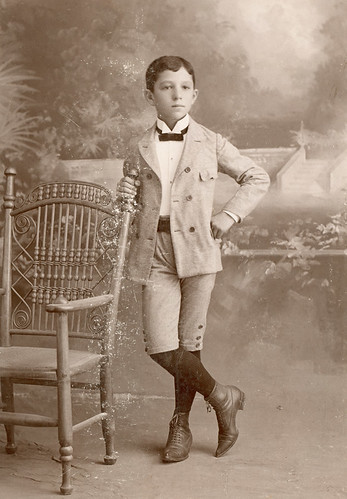
Gar Travis writes:
The word Century tipped me in this direction and he came to the United States in 1890 as a child: "Victoras Barnauskaus," or Victor David Brenner. ...and my second guess would be again based on the word Century: Eric P. Newman.
Martin Purdy writes:
I'll take a totally wild punt and say Farran Zerbe. The age of the picture looks about right, but I have nothing else to go on!
These are good guesses too, but it's not Zerbe, either. The first correct answer came from Dave Bowers, who writes:
I had not seen this picture of the youthful Benjamin Max Mehl before.
Charlie Davis also had the correct answer within minutes of Dave's response. So did Pete Mosiondz, Jr. and Ed Reiter, who writes:
Facially, that old-time young numismatist in this week's mystery photo is a perfect match (as in matchbook) for B. Max Mehl.
Dave Lange agrees:
I haven't seen that photo before, but the subject bears a notable resemblance to the mature B. Max Mehl.
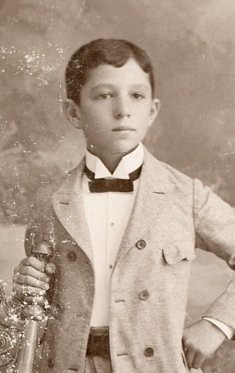
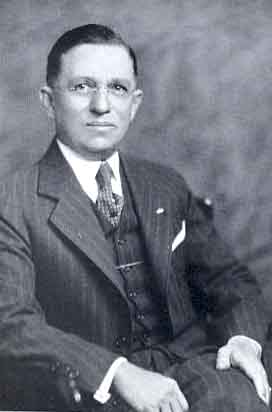
Robin Sisler adds this information about the photo:
"It's B. Max Mehl in 1896 at the age of twelve taken soon after his family moved to Ft. Worth, Texas. Mehl was already dealing at this age, having begun collecting at ten. This image (only the head) was used in some of Mehl's advertising. Ex Mehl estate, Kosoff, Stocker. If anyone is aware of an earlier image of Mehl, please let me know."
THE BOOK BAZARRE
EXPERIMENT: WERE ANCIENT COINS WERE STRUCK HOT OR COLD?
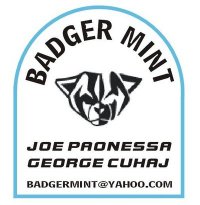 I’d like to announce a little experiment in hot- and cold-striking brought to you by Scott Rottinghaus, and the Badger Mint Staff - George Cuhaj and Joe Paonessa. This exercise is to be conducted during Session I of the ANA Summer Seminar in Colorado Springs, at the end of this month.
I’d like to announce a little experiment in hot- and cold-striking brought to you by Scott Rottinghaus, and the Badger Mint Staff - George Cuhaj and Joe Paonessa. This exercise is to be conducted during Session I of the ANA Summer Seminar in Colorado Springs, at the end of this month.
There have been several interesting discussions in various arenas on the topic of whether ancient coins were struck hot or cold. Our plan is now to do this striking experiment in a controlled and properly documented fashion in order to compare the results of hot-struck and cold-struck coins.
Process:
Using the same pair of dies and blanks of the same weight and purity (approximately 8 grams and 97% silver), strike 100 pieces cold, and then strike 100 pieces hot.
Materials:
Pair of dies (to be engraved by hand by Joe Paonessa).
200 blanks of similar weight and fabric (to be fabricated by the Badger Mint).
Ancient mint set-up of the Badger Mint - anvil die mount and hammer.
Tongs, trays, 200 envelopes to keep track of strikes. Propane torch and charcoal block.
Staff: the same striker, die setter, blank setter, and torch assistant.
On the first day, proceed by first test striking 10 blanks as test strikes, then strike an additional 100 blanks cold, at a comfortable speed.
On the second day, proceed by first test striking 10 blanks hot as test strikes, then strike an additional 100 hot blanks, at a comfortable speed. These hot blanks would be heated approximately 10 at a time to red hot (close to the melting point), and then transferred to the die as safely (but also as quickly) as possible and struck.
The dies would be of Greek style, with relief designs on both the hammer and anvil dies, images can now be seen on the Badger Mint Facebook page.
The hammer die will be marked, and we will attempt to maintain die alignment.
With the intention of publication, we will study the results after each group of 100 is finished as well as scan or photograph all 200 specimens as a record. We will also record observations on the striking process, including speed.
The cost of the silver and the fabrication of blanks and dies will account for most of the expense of this experiment. If anyone on this list would like to contribute to this project (and receive some of the finished products in return), we are currently seeking 45 contributors at a price of $65 each. Please mail checks to The Badger Mint, PO Box 2, Iola, WI 54945. Each contributor will receive two hot strikes and two cold strikes, sent postpaid. When sending in payment, choose two numbers between 11 and 98, with alternatives. Those will be the strikes you will receive.
The ANA Museum will receive the dies as well as two hot and two cold strikes.
Best wishes,
Scott Rottinghaus
George Cuhaj
Joe Paonessa
MORE ON THE 1794 DOLLARS
Kerry Rodgers writes:
I was writing up a story on the sale of the 1794 dollar and came across a reference to Hoagy Carmichael having once owned the coin. In turn this led me to a NY Times report of yesteryear. Editor Ed was most amused when I pointed out his by-line.
The late Hoagy Carmichael, one of America's best known songwriters, also was a first-class coin collector. That fact will be dramatized next month when his fine collection is sold at auction in Los Angeles. Mr. Carmichael's coins figure to bring upwards of a half million dollars.
To access the complete article, see: COINS; HOAGY CARMICHAEL'S COLLECTION (www.nytimes.com/1985/12/08/arts/coins-hoagy-carmichael-s-collection.html)
Kerry adds:
Also related to the 1794 sale, the Handbook of Texas, produced by the Texas State Historical Association, refers to Amon G Carter Jr as having helped found the "International Paper Money Society." Have any E-Sylum readers ever heard of it? Or is the Handbook a little confused? See CARTER, AMON GARY, JR. (1919–1982) (www.tshaonline.org/handbook/online/articles/CC/fcaaj.html)
Alan V. Weinberg writes:
I had the pleasure of closely examining the Neil-Carter-Terranova -Milas/Browder-Lustig-Contursi 1794 dollar back when it was for sale at Ed Milas' ANA bourse table for $375,000 perhaps three decades ago. I understand it did sell at that show and that co-owner Marv Browder was unhappy it sold and wanted to buy it back he was so enamored of the coin. I don't blame him! But, I don't know where the tale started that this was the 1st silver dollar struck at the US Mint and was struck for presentation or specimen purposes.
Perhaps it started with B. Max Mehl's often overblown cataloguing descriptions. But the coin's planchet is heavily and prominently adjusted to the point where a significant amount of the reverse peripheral inscription is very weak and obscured. There are a number of high grade 1794 dollars (AU and better) that have considerably fewer adjustment marks and much stronger reverse legends although admittedly not the original toning and prooflike surfaces of this now-Logies /"Cardinal" specimen.
It's a matter of taste and aesthetics which 1794 dollar is "the best" . There are 3-4 Mint state contenders. But it is highly unlikely the Mintmaster would have intended to strike such a heavily file-adjusted coin as an example of the first dollar, much less one for diplomatic or Congressional presentation, as an example of the early Mint's "best work".
Dick Doty of the National Numismatic Collection at the Smithsonian writes:
Funny thing about that 1794 dollar. Contursi wanted me to state in writing that, in my opinion, it was the first dollar struck. I told him I didn't do theology, and there the matter stopped.
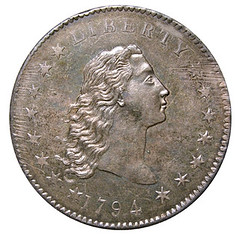
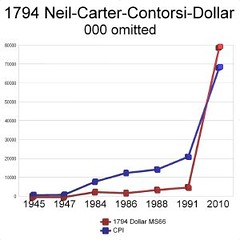
Bill Eckberg writes:
Every time I see a graph like the one by David Ganz describing the sales prices of the Neil-Carter-Contursi 1794 dollar in today's e-Sylum, the scientist in me goes ballistic. Everything about this graph is presented in a manner so misleading that it reminds me of the old book, "How to Lie with Statistics".
The spaces between the dates are equal, but the time intervals between them are very unequal, and the vertical axis is linear, but it should be logarithmic, since doubling the value from $1 to $2 over time period X gives the same rate of return as doubling from $1M to $2M over the same time period. When plotted that way, the data points plot as an amazingly straight line.
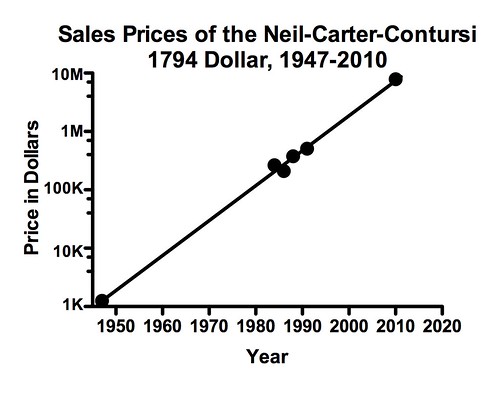
This shows that since 1947, the rate of return on investment of this coin has been constant. The one sale where the price dropped slightly does not change that fact. This graph could easily be extrapolated to the future to predict when the coin will sell for $10M or even $100M or $1B, but I will leave such speculation to others!
To read the earlier E-Sylum article, see: FINEST 1794 DOLLAR SALE PUBLICITY (www.coinbooks.org/esylum_v13n22a26.html)
ON FINDING HARD-TO-FIND LOW-PRICED WORLD COINS
James Higby writes:
Heath McAlpine's observes, "Many of the issues in Krause that catalog for a few bucks or less are terribly difficult to find." I suspect that this results from a coin issue being held in a vault after manufacture and never released, especially in the case of modern world coins.
Just last week I was outbid bigtime on an eBay lot for a circulated (!) Sudanese 10-millim dated 1971. It catalogs for "a few bucks", but ended up hammering for well over $100. This begs the question, "Should the catalog values be increased to reflect actual scarcity, whether real or artificial, or should they be kept low in anticipation of an eventual release which might or might not occur in my remaining lifetime?"
Chick Ambrass writes:
Here's a possible hint for Heath concerning getting some of those coins for his birth year set. I took the lead from another E-Sylum subscriber, Ed Krivoniak, who has a 1949 collection. My birth year is 1952.
In 1952 there were 132-134 different coins struck in the world. I have about 110. There are a couple of rarities: coins struck, and then melted back to bullion, with only a half dozen pieces known; and about 20 gold pieces with me having only one. I cannot justify the price on the others.
The low cost common world coins are so cheap you don't see them listed on eBay - it just doesn't pay anyone to do it. Here's the hint for finding them.
For example, Brazil has 5-6 denominations in 1952. In uncirculated condition are all worth less than a dollar. What I did is look for a dealer on eBay selling Brazilian coins (who resides in Brazil). I contacted him and offered to pay him a "finders fee" to locate the 5-6 coins and mail them to me.
I paid via PayPal 2-3 dollars for the coins, the postage and an agreed-upon fee. I acquired a number of low cost uncirculated coins that way.
I'd also like to wish Ed Krivoniak a speedy recovery from some recent surgery. Good luck! -Editor
DICK JOHNSON ON PRESIDENTIAL COIN &ANTIQUE CATALOGS
I must congratulate you both for your chosen collecting topic of Society of Medallists and your desire to complete this series you mentioned in last week's E-Sylum. Also your wish to put together a collection of Joe Levine's auction catalogs.
Joe's catalogs (Presidential Coin &Antique) are extremely useful and will be more so in the future. I have indexed all of Joe's sales from #42 (June 1987) to date by citing each medal (sale and lot number) to the respective artist in my American Artist Databank (now over 2,800 pages in length and growing daily). I plan to put this on the internet in 2010, so you will have the opportunity to look up any American medal (whose artist or maker is known) to learn his brief biography, all the coins, medals and similar items the artist created, plus an extensive bibliography for that artist. Also recent auction sales, and the public collections where that piece is located (for a dozen museums) and where the piece has been illustrated.
Formerly I did this indexing by marking up one of Joe's catalogs. (Now I find it more accurate to photocopy each page and mark up the photocopy.) Thus it was my goal to have a double set of Joe's catalogs (to keep one pristine!). I only accomplished this by buying a run of Joe's catalogs in the Arlie Slabaugh library sale and paying a premium $600. And this did not contain the first 11 issues (which I subsequently obtained).
Heath, I hope you can obtain your set for less than what I had to pay, but as you surmised, you will find they are invaluable for the information, attributions and sheer collector lore they contain. Joe does an outstanding job in the preparation of his catalogs. This is even more incredible when you consider Joe is a one-man operation!
Heath replied:
I've been working on the SOM collection for quite some time; I bought my first example, #16 by Beach, way back when I was in college in 1978 from (drum roll) Johnson &Jensen. I bought a couple more from you (including a large bronze #28 by Schmitz) before life intruded and the collection went (mostly) on the shelf.
I did join the SOM for a period of time in the late 70's thru the early 90's with a few gaps. I dusted it off several years ago, joined the Medal Collectors of Amercia (MCA), and got serious about finishing it. I have about six left to get, including the two of the terribly difficult to find late ones (the Weinman and the Moss pieces).
It's been a lot of fun putting the collection together, and I've had some interesting experiences with it. A reference would have been a great boon in the process although, when one is published, I fear we might see too much popularity. I understood that Mr. Scarinci was at work on it. Do you know if the project progresses?
I agree with your assessment of the Levine catalogs. First rate stuff, and just fun to read. As I finish up the SOM collection, I plan on using them to pick a new direction for my efforts. Your index will be very valuable.
Finally, as someone who was raised up on Whitman folders and the Redbook, it amazes me that there doesn't seem to be a good, comprehensive reference on the medals of the US Mint. Julian is very interesting, but we have a small gap from the point where it concludes to the present. Is there something out there besides the Mints early 70's sales catalogs and I've missed it? If not, I would nominate this area as one for the MCA to consider if they beginning commissioning new works.
To read the earlier E-Sylum article, see: SUBSCRIBER PROFILE: HEATH MACALPINE (www.coinbooks.org/esylum_v13n22a17.html)
GLOUCESTER TOKEN REPRODUCTIONS OFFERED
A few E-Sylum's ago, someone mentioned the Gloucester Token. This is an extremely rare American token and when it was mentioned to me about five years ago, I thought I would go to Gloucester, Virginia and see what I could find out about it. I shop in Gloucester every once in awhile from my house in Deltaville, so the next time I was there, I drove over to Main Street, the old part of the town. I could not find a coin store so I walked Main Street and stopped in antique stores. One of them knew about the token and showed me a copper or brass replica he had for sale for $5!
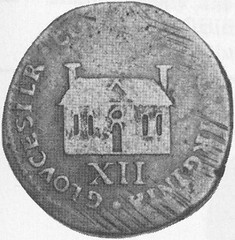

Genuine Gloucester Token
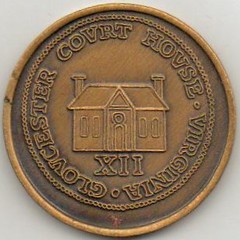
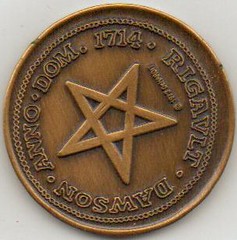
Replica Gloucester Token
 The antique store dealer told me it came from the DeHardit Press in Gloucester, which publishes a local newspaper called Glo-Quips. Someone in the press had the replica's minted in 1973 and even copyrighted them. They have been selling them for $5. each for years and add on another $1 for postage and handling if you order it through the mail. They do not have a website and do not use PayPal or use other online payment systems so you will have to order the old fashion way with a check for $6. to:
The antique store dealer told me it came from the DeHardit Press in Gloucester, which publishes a local newspaper called Glo-Quips. Someone in the press had the replica's minted in 1973 and even copyrighted them. They have been selling them for $5. each for years and add on another $1 for postage and handling if you order it through the mail. They do not have a website and do not use PayPal or use other online payment systems so you will have to order the old fashion way with a check for $6. to:
DeHardit Press
7339 Lewis Avenue
Gloucester, VA 23061
I wrote about this replica's availability in an article for Numismatic News when I discovered it. There were quite a few orders to the antique store where I bought mine and I have no idea how many were ordered from the press. The antique store went out of business so you will have to order from the press.
I have scanned an image of the advertisement from one of my old issues of Glo-Quips, and both sides of the replica so they can be shown in The E-Sylum. I am sure there must be some more collectors out there who will want to fill a hole in their collection for the Gloucester Token with this replica.
To read the earlier E-Sylum article, see: ANOTHER EARLY FIVE-POINTED STAR ON A U.S. COIN (www.coinbooks.org/esylum_v13n09a12.html)
NOTES FROM E-SYLUM READERS: JUNE 6, 2010
Dave Bowers writes:
Gradually in Newburyport the description of the Perkins factory has been changed from "mint" (which it was not) to "printing factory" or similar, which it was.
Really great issue. You must have spent a lot of t-i-m-e on this issue! Keep up the good work.
Regarding the Science Daily article on coin analysis techniques, Stuart Williams, a Biochemist from Ireland found us through Flickr. He writes:
Mass spectrometry is ideal for separating out isotopes and measuring the ratios in which they are present. True, the ratios and types of isotopes of lead can be a signature that identifies a source of silver ore.
However, interpreting isotope analysis from silver coins can be tricky and extra caution advised in interpreting their results. The assumption that coins were generally minted from freshly mined silver may not always hold true. Quite often silver and other metals used to mint coins were refined at the mints and may well have come from other sources such as reused silver plate, old coins, foreign coins as well as freshly mined silver. So these mixed sources will also mix up the isotope ratios and render analysis unintelligible.
However, having said that, metallurgical analysis of coin series can invaluable, produce fascinating results and an insight into how they were produced. But very careful specimen preparation before testing and careful interpretation are vital.
Joe Boling writes:
Regarding the Coole-Kozono-Bowker Bibliography of Far Eastern Numismatology, if you look on page 150 you will see daggers on four of the listings. Page 149 explains that the daggers are for "dependable and outstanding" works. These were to be on the Japanese titles only, with Kozono doing the evaluating.
When I asked him why only four titles were marked, he said that he (or they - I don't remember which now) had decided that it would impolite to mark books when there were still authors living (whose work would presumably not make the cut). But he provided me the list of books that were supposed to have been marked.
I have intended for years to write a short article for The Asylum giving Kozono's list (he is long dead and most or all of the offendable authors are, as well), but I have never gotten around to it. Is there interest in the list?
Alan V. Weinberg writes:
The Bill Rosenblum June 10th auction rim-hallmarked silver Mercator medal is a mid-20th century European struck copy which comes gem prooflike, often in a plush blue case. I've owned several.
I still maintain that it strains credulity to think that the 16th century engraver Mercator produced more than one of these intricately engraved originals. The hand engraving work is profoundly skilled and detailed and , by its nature, unique - no other specimen could be closely alike. Hence the $50,000 auction price in the 1960's- today easily a Million dollars.
All other alleged "nine" specimens are either casts, electrotypes or more modern replicas. Museum curators too often cannot discern the differences.
Chick Ambrass writes:
As far as rhyming with "purple" ....Roger Miller of "King of the Road" fame...in the early '70's wrote and recorded a song of which the title escapes me...but I've always remembered one portion of the lyrics:
Roses are red, violets are purple
Sugar is sweet, and so is maple syrple
Ken Berger writes:
Purple rhymes with Curple. It is an English word used in Scotland and refers to the hindquarters of a horse.
The other three words (month, orange, silver) have what are called half-rhymes, such as lozenge with orange.
A full stressed rhyme (e.g. hand with stand) or a full unstressed rhyme (e.g. handing with standing) contain vowels common to both words. A half-rhyme has differences between vowels in certain syllables.
WAYNE'S NUMISMATIC DIARY: JUNE 6, 2010
So what numismatic items were in my car at the time of the crash Tuesday? (See this week's Wayne's Words for details.) Well, no 1913 nickels, real or fake. I didn't think I had ANY numismatic items in the car, but there turned out to be two. My wife drove me to the storage lot Wednesday morning and we salvaged what we could of my belongings from my wrecked car.
In the glove compartment I found an envelope that must have laid there undisturbed for years - at least five, probably more. On the outside I wrote a note to an acquaintance, Frank Lucchino of Pittsburgh. The local politician lived in the same neighborhood I did before I got married.
I forget how we met, but I learned we shared an interest in collecting old Pittsburgh postcards. We got together and traded duplicates, but I got the better of the deal - I needed more of his than he did of mine. So I felt like I owed him, and when I came across something I thought he'd like I put it aside for him.
Looks like I put it aside for way too long. I had planned to drop it off at his house, but it got buried in my glove box and forgotten. Sorry, Frank!

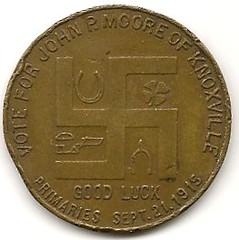
What I had was a political item from a 1915 Pittsburgh election. It's a large-cent-sized copper token promoting "John P. Moore of Knoxville for Controller of Allegheny County", the same position Lucchino held for twenty years. It's a "Good Luck" piece with a swastika on the obverse. Neat little item. Probably rare today, but not terribly valuable. I guess it's one lucky piece I'd better keep now.
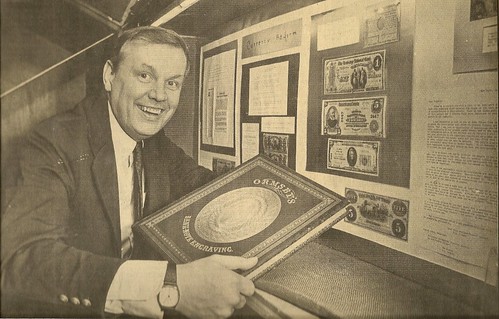
The other item was an oversized piece of paper ephemera. It had been stored for years in my late mother's attic. I'd forgotten to take it out of the trunk the last time I drove back to Virginia. It was a gift from numismatic bibliophile Bob Wester, dated July 7th, 1989.
It's a matted copy of a page from the Concord Monitor. The page contains a nearly full-page article on Wester and his display of new Hampshire banknotes and Heath's counterfeit detectors at a local bank. I love the headline: "Boodles of Queer." Bob is pictured with his prized copy of the rare Ormsby Banknote Engraving book.
I've found a spot for this in my library at home. Bob passed away several years ago, and it's a nice souvenir from a great biblio-buddy.
NEW CURRENCY ADVOCATED FOR PALESTINE
Negotiations on a future Palestinian state might be stuck in neutral. But Jihad al-Wazir, the closest thing to a Palestinian Federal Reserve board chairman, is planning one key aspect of statehood: what the money will be.

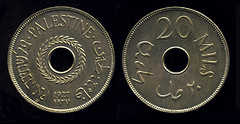
Over the past quarter century, Palestinians have mainly used the Israeli shekel and the Jordanian dinar for commerce. Now they're quietly considering reissuing the defunct Palestine pound, an example of which is displayed in a museum-like Lucite case outside Wazir's office, alongside coins from the time of Alexander the Great.
Quiet talk in the West Bank of a new Palestinian currency comes amid a push by Prime Minister Salam Fayyad to ensure the Palestinians can function independently of Israel if they gain sovereignty through peace talks or issue a unilateral declaration in two years if negotiations fail. Fayyad has been working to reform government institutions, professionalize the police force and establish mundane bodies such as a statistics bureau.
"All options are open, as far as we're concerned -- issuing our own currency is one," Wazir said in an interview, adding that the Palestinians are exploring linking the future currency to the dollar or the euro -- or perhaps adopting one of those instead of the shekel.
Even with that caveat, all signs show the Palestinians are at least getting ready to issue their own dough. Bulldozers recently broke ground on a new Palestine Central Bank building that will include specialized vaults.
The notion of a Palestinian currency has long been a matter of controversy with Israel, whose 20-times-larger economy the Palestinians have depended on for decades. At the outset of the Oslo peace process in the early 1990s, negotiators set aside the idea amid Israeli concerns that it would be too bold a sign of independence and fiscally foolish.
By 2000, the last time Israelis and Palestinians engaged in serious peace talks, a committee of Israelis and Palestinians blessed the idea before the talks collapsed. Yet, despite recent economic reforms welcomed by the World Bank and others, Israeli officials remain skeptical that the Palestinians can abandon the shekel.
"Their economy is too small,'' an Israeli official said. "It will need something to sustain the currency. Currency is not like a stamp or an international dialing code, which they have. . . . But to have a currency of your own, it's a whole other ballgame. They don't have what it takes.''
In the meantime, a committee quietly mulls what images to put on a new Palestine pound. The late Palestinian leader Yasser Arafat is a possibility, Wazir acknowledged, along with scientists, poets and artists.
"We're bringing something back to life,'' he said. "Hopefully, the politics will catch up.''
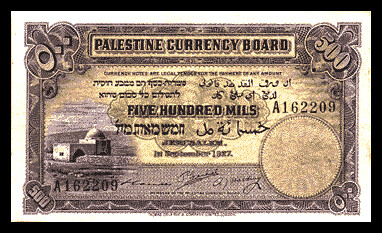
To read the complete article, see: Palestinian officials think about replacing Israeli shekel with Palestine pound (www.washingtonpost.com/wp-dyn/content/article/2010/05/29/AR2010052903131.html)
THE BOOK BAZARRE
TECH TALK: COIN STRIKING PRESSURE CALCULATIONS
So here is my physics problem. I have built a "new and improved" (read heavier) drop hammer. I am curious how many pounds per square inch will be created upon impact on my die.
The weight is 50 Pounds.
The distance is 5 feet.
The surface area of the die is 1.25 square inches.
Using the Internet I am able to get it down to Kinetic Energy (337.84 J), but don't know if that can be converted into pounds per square inch.
My thinking is that my 50 pound weight is 8x6 inches (48 square inches). Sitting on the ground, that is a little more than 1 Pound per square inch. However, if it is sitting on a 1 square inch die, it is imparting 50 pounds per square inch. The energy is the same, but the area affected is different.
Raise it up and drop the weight 5 feet, the energy is the same whether it lands flat, or on a 1 square inch die. However, all the energy get imparted to a much smaller area when it hits the die.
There's my problem. I must don't know how to ask the Internet the right question to get the right answer.
I don't remember all the search string permutations that I tried, but they include things like "calculate force", "calculate pound per square inch", "convert Kinetic energy," etc. Also included "falling object."
So I got ways to calculate energy in a falling object, but no way to convert that to pounds per square inch.
I will include the answer and the calculations in the second edition! Hopefully, some one will provide the actual calculations and not just the answer.
I am not sure that it will be enough to strike my 1 oz. gold token. I will test it this weekend. I may have to lift it the 5 feet, and then "throw" it down, adding to the acceleration created by gravity. We shall see!
COMMENTARY ON THE COIN DOCTOR LAWSUIT
Dave Bowers writes:
 Regarding the close-up photo accompanying the press release, Joe Boling writes:
Regarding the close-up photo accompanying the press release, Joe Boling writes:
"This detail image of a 'doctored' Standing Liberty quarter shows the decomposition of soft metal...."
Presumably they meant "deposition."
Please, no one pinch me, this is one dream I do not want to end. My sincere congratulations to David Hall and Don Willis for taking the ultimate step in the fight on coin doctors-filing a lawsuit!
For years the situation with coin doctors has only been growing more desperate. The grading services have been fighting them as hard as they could privately. Every time they thought they had a handle, the coin docs just figured out new ways to continue their destruction. This lawsuit is not for glamour, rewards, or a money grab, it was a necessity. PCGS has done the absolute right thing.
There is a rotten to the core subculture of coin dealers close to these guys who truly believe that it is their right to doctor, recolor, or do whatever they please to coins for a living. These people have little respect and nothing but contempt for the grading services and the public. Its time they learn they are not above the law.
Its mindboggling these greedy whores fail to realize is that FRAUD has been committed. One dealer said to me "Its the grading services job to not allow doctored coins to get through". True. However, it is against the law to try and defraud them by altering the coins they submit. Once this complaint starts progressing, the peripheral players will be exposed.
Those are the guys who really have to be sweating right now. They are the ones who quietly sent coins off to these guys to have the work done for them while they look clean. I think you'll be shocked to see who some of these names are-especially including some well known longtime PNG members.
Plus, sooner or later, it probably will be exposed about a few major firms who employ well known coin docs. They will be a tougher fight because they hire them and called them "conservationists or curators". In the end, they won't win-the evidence will be too overwhelming.
PCGS has started the fight "right". They are not just shooting the dark, they gathered the most facts and proof possible then waited for the right opportunity to file the complaint.
My only hope is that PCGS goes after as many of these guy as they can. The amount of serious coin doctors is actually small relative to the number of total dealers in the business. However, the ones listed in this complaint are just the tip of the iceberg. There are others out there who mix chemicals, recolor coins, add frosting, etc. and brag about it within the dealer world.
I have no sympathy for these guys. Their work has made my life miserable and has hurt collectors. They are not around when a customer comes back in a few months or a year or two to show me how the coin I sold turned (note: when a coin is first messed with it can be impossible to detect). Or how when a customer sells their collection and it has become all dreck and I am the one who has to tell them.
I have lost hundreds of thousands of dollars buying coins back and I am sure the grading services have lost millions. Even if PCGS has to spend a million dollars on this suit, it will be cheaper for them in the long run.
The public needs to speak out more and push organizations with power-like the ANA and the PNG to take action. If collectors know of someone doctoring coins-even on small level, avoid them and tell the grading services. Make your dealer stay away from the bad guys. Write letters to Coin World or discuss the issue on collector forums. Yesterday, a small but significant step was taken in this critical war. We can win and stop the majority of the coin doctors!
To read the complete blog article, see: THE PCGS LAWSUIT (www.legendcoin.com/cgi-bin/inventory/cms2.pl?page=hot_topics)
John Feigenbaum of David Lawrence Rare Coins had this to say in his June 1st blog:
From my perspective, action against the "coin doctors" has been overdue. For years, these guys have enjoyed an unfair advantage in the U.S. coin market and their presence in the general marketplace and auctions made it more difficult for legitimate buyers to compete. But we all accepted their existence because these folks have been around as long as there was a profit to be made in artificially improving coins.
The grading services were designed originally to eliminate this scourge, but these guys are good and their methods are ever-improving. The extent of the doctoring of late has been somewhat hidden during this time, so some of the revelations in the filing are news, even to me. Now, it seems PCGS has drawn a line in the sand and they are throwing the book at some known offenders. More like a hammer, actually.
To read the complete blog article, see: David Lawrence Rare Coins View on PCGS’ Hard Stance Against Coin Doctors (www.stellacoinnews.com/index.php/david-lawrence-rare-coins-view-on-pcgs-hard-stance-against-coin-doctors/)
STILL MORE ON CHINESE COUNTERFEITS
Stuart Williams of Ireland writes:
It is frightening the quality of die-struck counterfeits coming from China and elsewhere these days. This problem will undermine the popularity of coin collecting.
I've seen many examples of modern die-struck counterfeits in the Yahoo Groups and only an experienced collector or expert could tell them apart from the genuine examples!
Michael E. Marotta writes:
If you search the Google Groups discussion board Rec.Collecting.Coins, you will find that warnings about this new generation of frauds go back to 2004. More recently a summary of Gregory Dubay's ANA's 2009 National Money Show Philadelphia, "Numismatic Theater" presentation was posted there by username Peter. According to that: "For their highest grade efforts ... they use actual planchets made for the US mint, they have surplus presses from the US mint, they have discarded US dies and die steel..."
You can find uploads on NumisMaster from Skip Fazzari's articles for Numismatic News. (See "Chinese Fakes Get Harder to Spot Over Time," by F. Michael Fazzari, Numismatic News; June 04, 2009.) Coin World editor Beth Deisher teamed up with About.com's Susan Hedley to publicize the problem as widely as possible. Deisher and Hedley spoke on this at the 2009 FUN convention and at the ANA 2009 World's Fair of Money in Los Angeles.
For all of that, I have to report that there was some disappointment in the Counterfeit Detection Seminar by ANA instructor Mike Ellis at the 2010 Michigan State Numismatic Society Spring Convention. I did not attend. It was reported to me that when asked about Chinese counterfeits, Mike Ellis "kicked it under the table" and said that it was not a problem.
MSNS member dealer Chuck Sharpe wrote: "If that is the case then understand that Ellis opened the seminar by asking attendees what they expected to get out of the day's session. When it was my turn I introduced myself and said I would like comments on the Chinese counterfeit invasion because I feel it to be a serious threat to our hobby and business. Ellis said there was really no big issue because the items are so obvious and that the 19th century trade dollars counterfeits were the best Chinese work."
PHILIPPINE GUERILLA NOTE FAKES
A number of articles have been published in The E-Sylum about the plethora of counterfeit coins coming out of China. There is a similar situation with respect to the Philippines. A number of years ago, numerous counterfeits of Philippine Guerrilla currency started appearing on eBay.
More recently, counterfeit overprints have started appearing. Many of the major dealers/collectors in the Philippines are aware of these notes and of the individuals producing them. These counterfeits have now entered into the collector market and are being sold as genuine both by honest and unscrupulous dealers/collectors. I have found numerous examples for sale at a number of coin shows.
Unfortunately, many dealers do not want to admit the notes they are selling are counterfeit because, in many cases, they paid a few hundred dollars for them. I have gotten into a few arguments with dealers who have refused to even consider the possibility that their notes are counterfeit. Of course there are always exceptions, such as Ray Czahor, who has even listed on his website ways to distinguish some of the counterfeit from the genuine notes. However, he is the exception rather than the rule.
My advice is when purchasing:
1)rare guerrilla notes or overprints, or
2)previously rare guerrilla notes in high condition, or
3)previously unreported guerrilla notes or overprints,
that a provenance be requested. If the origin of the note can not be traced back at least ten years then stay away.

To view the Czahor page of Philippine Guerilla Note Fakes, see: mysite.verizon.net/cookiejarpi/PhilippineGuerillaNoteFakes.htm
SOLDIERS RETURNING WITH FAKE U.S. COINS
Harold Levi writes:
Here is an article about fake 1804 dollars being brought home by our soldiers. A fellow SCV (Sons of Confederate Veterans) member sent it to me. He lives in Hohenwald, Tennessee. Hohenwald is southwest of Nashville.
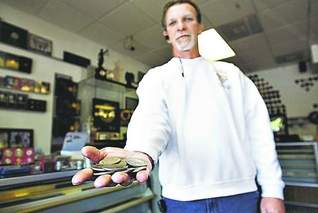 Everett, owner of Tiah's Coins and Currency on Fort Campbell Boulevard, has accumulated more than 550 seemingly rare coins brought in by soldiers returning from the two countries who’ve been led to believe they’ll make money selling the coins back in the U.S.
Everett, owner of Tiah's Coins and Currency on Fort Campbell Boulevard, has accumulated more than 550 seemingly rare coins brought in by soldiers returning from the two countries who’ve been led to believe they’ll make money selling the coins back in the U.S.
"They’re not realizing they’re committing a felony," Everett said. The coins are counterfeit — worth nothing more than the 22 grams of steel they’re made from.
Of particular concern for Everett is the small stack of 1804 silver dollars he's collected. Only about 15 legitimate coins exist, with some valued at more than $4 million.
"The 1804 dollar is one of the most publicized rarities in the entire series of U.S. coins," says the "Red Book," the official buyer's guide to U.S. coins.
Everett has 10 of the coins himself, all of them counterfeit, all of them brought in by soldiers returning from combat. "These guys are getting ripped," Everett said.
Everett proudly displays a photograph brought to him by a chaplain at Fort Campbell of an Afghan man on a U.S. base selling coins on a blanket. The man, in tattered clothes and with dirty fingers, is wearing a pass around his neck that allows him access to the base.
"We’re assuming the money is going back to the enemy," he said. "What fears me worst is these (soldiers) could be buying their own bullets to be shot at them."
Leaders of the 3rd Brigade Combat Team in Afghanistan say Everett's assumption is a "stretch," but it is possible.
"It is no secret that many of the Afghan contractors who work building our (forward operating bases) have to pay for protection or pay ‘taxes’ to stay alive," the brigade said in a response to e-mailed questions. "It is reasonable to think the vendors selling trinkets in the bazaar must do the same.
To read the complete article, see:
Soldiers returning with fake U.S. coins
(http://www.theleafchronicle.com/article/20100601
/NEWS01/100531004/1002/Soldiers-returning-with-fake-U.S.-coins)
THE 1944 SILVER SAUDI RIYAL COIS
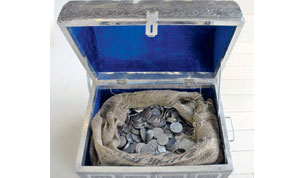 The Museum of Islamic Art yesterday announced that it has received a collection of 1,000 silver Saudi one-riyal coins from Saudi businessman Bassam Omar Salama.
The Museum of Islamic Art yesterday announced that it has received a collection of 1,000 silver Saudi one-riyal coins from Saudi businessman Bassam Omar Salama.
The collection was among 3mn Saudi one-riyal coins minted in the United States in 1944 during World War II at the request by then Saudi king Abdul Aziz bin Abdurrahman al-Saud.
In a letter he sent to the museum on the occasion, Salama said he had received 3,000 silver Saudi one-riyal coins and was gifting 1,000 of them to the Museum of Islamic Art in recognition of its role in preserving rare Islamic collections.
Recalling the history of the rare treasure, Bassam said a cargo of 3mn silver Saudi one-riyal coins was shipped to the port of Ras Tannoura, in Saudi Arabia's Eastern Regionm, during WWII.
But the ship that was transporting them, SS John Barry, never arrived.
Torpedoed by a German U-boat in the Arabian Sea more than 185km off Oman in August 1944, the ship broke in two and sank. She sank in waters so deep that no one thought she could ever be salvaged.
The treasure remained underwater until 1994 when a team of Bassam's friends financed an operation to recover the treasure with the aid of the US government, which provided them with information about the ship and the cargo.
With the approval of Sultan Qaboos bin Said of Oman, they established the Blue Water Company to recover the treasure, the Saudi businessman said.
Bassam added that in November 1994, using satellite and the state-of-the-art technology in the field of diving, the team recovered 1.4mn riyals from the total of 3mn riyals in an operation described by international media as the "strangest, biggest and deepest recovery operation in history
From the Wikipeedia entry on the SS John Barry:
The SS John Barry was a 7200-ton American liberty ship in World War II. The ship left its convoy under radio silence to go on a mission to Dhahran in Saudi Arabia when it was torpedoed 185 kilometers off the coast of Oman by the German submarine U-859 on 28 August 1944. Two crewmen were killed in the sinking and the survivors were rescued the next day.
The SS John Barry was carrying a cargo of 3 million American-minted Saudi one-riyal silver coins as an American payment associated with ARAMCO. The reason for this shipment (one of several during the war) was that Saudi Arabia did not use paper money at the time and this led to a war time shortage of currency with which to pay workers building new oil refineries and other US facilities at newly founded Dhahran.
Further information may be found in the 1995 book "Stalin's Silver" by John Beasant, published by Bloomsbury
Minted in Philadelphia at Saudi Arabia's request, a cargo of three million silver Saudi one-riyal coins was shipped to the oil port of Dhahran, in Saudi Arabia's Eastern Province, late in World War II. But the Liberty ship that was transporting them, the S. S. John Barry, never arrived. Torpedoed by a German U-boat in the Arabian Sea more than 185 kilometers (100 nautical miles) off Oman in August 1944, the John Barry sank in waters so deep that no one thought she could ever be reached.
Workers building the new refinery had to be paid; paper money was not yet in use in Saudi Arabia; and by 1943 the kingdom—and Aramco—had run short of riyal coins. The world economy was so unsettled that the riyals in circulation were valued more for their silver content than as a medium of exchange. Les Snyder, who was an Aramco employee in Dhahran in 1944, recalled that the company had to "scrounge for local supplies of riyals," even sending him to Riyadh to buy coins from merchants there.
The currency shortage was finally resolved when the Saudi government, under the terms of the 1941 Lend-Lease Act, arranged to buy silver in the United States to be minted into riyals in Philadelphia. The first American minted coins arrived in Saudi Arabia in the autumn of 1943, marking the beginning of a new relationship between Washington and Riyadh, and by the end of the war a total of 49 million riyals had been shipped unscathed from the United States to Saudi Arabia. The only consignment lost was on the John Barry.
Hudson says that building the recovery equipment and raising the coins from such unprecedented depths was a victory in itself. "It was a great relief that we found the riyals. It gave us all a buzz," he says. "It was rewarding to see such an effort prove itself."
Financial rewards were harder to come by, however. Almost exactly a year after the recovery, on a rainy November night in Geneva, the coins were put up for auction by Sotheby's as a single lot. In spite of heavy advance publicity, they failed to attract a bid at a starting price of about eight million dollars.
Coin reference books list the value of uncirculated 1944 riyals as about $12 each, so the entire hoard, if each coin could be restored to mint condition, might be valued at $15.6 million. Sotheby's representatives, in pre-auction interviews, described the coins as representing a unique "slice of history—more valuable than just the coins themselves."
To read the complete article, see:
Saudi businessman gifts rare coins to museum
(www.gulf-times.com/site/topics/article.asp?cu_no=2
&item_no=365928&version=1&template_id=36&parent_id=16)
BRITISH ARTIST CREATES PORTRAIT OUT OF PENNIES
An artist has created a self-portrait - using a staggering 5,500 pennies.
Mary Nugent spent a year collecting the £55 worth of coppers for her extraordinary piece. It then took a further month for the 47-year-old to painstakingly assemble all the pennies into the five-feet-tall portrait.
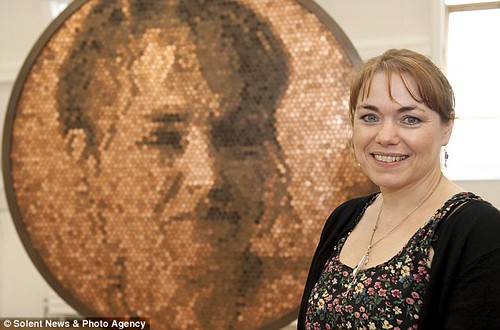
Ms Nugent, from Streatham, South London, said: 'I saved my change and also had lots of people out gathering them for me. 'I then took lots of different photographs of myself and eventually chose one I could break down into five different shades. 'I used chalk to draw the picture onto some MDF and then started filling it in with the coins, some of which had been outside for five months to darken.'
Miss Nugent said completing the artwork was a 'real challenge' as she had never undertaken anything like it before. 'Every time I placed a few pennies I had to walk back 10 feet to see if it was right and I didn't have much space to work in,' she said.
'Initially the coins were stuck with white tack and when I was happy everything was in the right place I stuck them all individually with glue. 'I was really nervous about what kind of reaction it would get but I've been overwhelmed by the positive response.'
To read the complete article, see: Copper load of this! Artist creates self-portrait using 5,500 pennies (www.dailymail.co.uk/news/article-1283055/Artist-Mary-Nugent-creates-self-portrait-using-5-500-pennies.html)
LORD ASHCROFT ON THE VICTORIA CROSS
The Lord Ashcroft Gallery at the Imperial War Museum in London opens to the public on November 12, 2010. -Editor
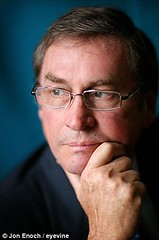 The new gallery, to which I have happily donated £5 million to build, will display the largest collection of VCs in the world - a collection that I started building nearly a quarter of a century ago. It will also display a formidable collection of medals already owned by or in the custody of the Imperial War Museum, including more VCs and George Crosses (GCs), sometimes called 'the civilian VC'.
The new gallery, to which I have happily donated £5 million to build, will display the largest collection of VCs in the world - a collection that I started building nearly a quarter of a century ago. It will also display a formidable collection of medals already owned by or in the custody of the Imperial War Museum, including more VCs and George Crosses (GCs), sometimes called 'the civilian VC'.
The gallery is a dream come true for me; the ultimate result of a fascination and admiration that I have had with bravery since I was a schoolboy. Unlike my father's generation, I have never had to fight for my country. But I was born the year after the end of World War II and, as I grew up, I heard countless references to the war years. This, in turn, gave me an interest in the war in general, and gallantry in particular.
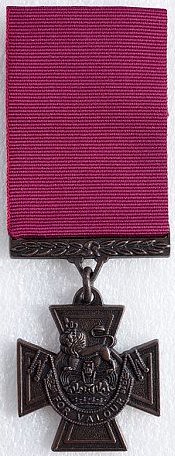 My late father, Eric Ashcroft, also proved an inspiration to me. As a young officer, he had been on Sword Beach at dawn on June 6, 1944, as part of the D-Day landings. The officers had been warned to expected 75 per cent casualties - dead and wounded - as they landed. Under heavy enemy fire, my father's commanding officer, a colonel, was shot dead at his side. My father was struck by shrapnel but he refused to be evacuated. He carried on fighting until eventually ordered from the battlefield, and his injuries were serious enough to end his front-line service.
My late father, Eric Ashcroft, also proved an inspiration to me. As a young officer, he had been on Sword Beach at dawn on June 6, 1944, as part of the D-Day landings. The officers had been warned to expected 75 per cent casualties - dead and wounded - as they landed. Under heavy enemy fire, my father's commanding officer, a colonel, was shot dead at his side. My father was struck by shrapnel but he refused to be evacuated. He carried on fighting until eventually ordered from the battlefield, and his injuries were serious enough to end his front-line service.
My greatest military interest of all has been the VC: a medal that represents everything that is best about Britain. It can be awarded to anyone - regardless of class, colour, religion, creed or rank - provided he (or she) exhibits truly exceptional courage in the face of the enemy. The VC was instituted through a Royal Warrant on January 29, 1856, which announced a single decoration - for valour - available to the Army and Royal Navy (and later the RAF). Since then, the medal has been awarded 1,356 times.
The trust is proud that within the collection are the VCs of Lieutenant John Chard and Private Robert Jones, two of no fewer than 11 Rorke's Drift VCs, the largest number ever awarded for a single military action. To place this into context, remember that just one VC was awarded throughout the whole of the Battle of Britain and just one for the D-Day landings.
I have made the journey - for me the pilgrimage - to Rorke's Drift and have tried to imagine the courage that was displayed by those fine soldiers, and especially by those two young men. Incidentally, contrary to reports earlier this year, I purchased the Chard VC nine years ago, at a competitive market price, and only after it was authenticated by experts and certainly not when there remained any speculation that it might be a replica medal.
To read the complete article, see:
Lord Ashcroft on the romance and tales of exceptional valour behind the Victoria Cross
(www.dailymail.co.uk/home/moslive/article-1283196
/Lord-Ashcroft-romance-tales-exceptional-valour-Victoria-Cross.html)
FEATURED WEB SITE: CHINESE REPLICAS OF FRENCH COINS
This week's Featured Web Site is suggested by Michel Prieur, who writes:
A reader of the Bulletin Numismatic, Frank Chetail, has developed a complete website of Chinese replica of French coins. I believe it can be helpful even to people who do not speak French. It includes all cgb.fr data and keeps on growing when new fakes are discovered. These fakes are very dangerous and deceptive.
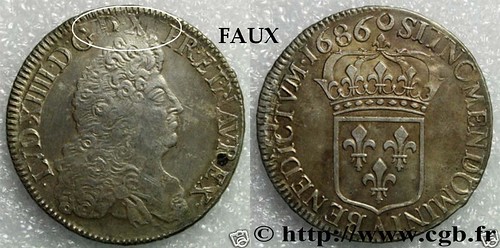
sites.google.com/site/copiereplicamonnaiesdefrance/

